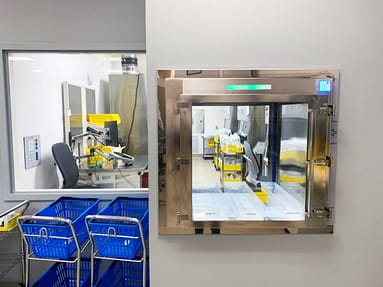Building owners and operators must constantly adapt to ever-changing local, state, and federal regulations and keep up with current technologies to ensure the safety of healthcare professionals & patients and to support environmental protection. This article highlights recent and upcoming changes to sterile compounding facility regulations found in USP <797> and USP <800>.

In November of 2022, the United States Pharmacopeia (USP) revised Chapter <797> of its regulatory standard titled Pharmaceutical Compounding – Sterile Preparations. This chapter “describes the minimum standards to be followed for the preparation of compounded sterile preparations (CSPs) for human and animal drugs” (USP <797>, Introduction and Scope). USP <797> is primarily intended to protect patients who receive medications prepared in a compounding pharmacy by preventing contamination and ensuring drugs are mixed & appropriately handled.
In February of 2016, USP <800> titled, Hazardous Drugs – Handling in Healthcare Settings, was published and applies to handling hazardous drugs. This new chapter became official on December 1st, 2019, but will not be enforceable until revisions to its referencing chapter (USP <797>) become official on November 1st, 2023. USP <800> “describes practice and quality standards for handling hazardous drugs (HDs) to promote patient safety, worker safety, and environmental protection” (USP <800>, Introduction and Scope). This chapter outlines the engineering controls and policies that facilities and healthcare professionals must follow while handling and storing hazardous drugs within a healthcare setting.
On November 1st, 2023, the most recently published version of USP <797> will become official; therefore, enforceable at the discretion of applicable regulatory jurisdictions. By extension, USP <800> will also become enforceable at that time. Before these changes take effect, building owners and operators are expected to ensure their facilities comply with these standards. They should take proactive steps to mitigate potential facility downtime or punitive action.
Notable changes required by USP <797> and USP <800> pertaining to air change rate, air quality, and pressurization requirements include but are not limited to, the following.
- All hazardous drug compounding areas must have a negative pressure relative to adjacent spaces within 0.01 to 0.03 inches of the water column (IWC). Previously, this requirement was negative 0.02 IWC or greater.
- Cleanroom suites should be maintained at a temperature of 20° (Celsius) or cooler and relative humidity of 60% or below. Previous temperature and humidity requirements were not established.
- ISO Class 8 rooms must have an air change rate greater than 20 air changes per hour. Previously, the air change rate for ISO Class 8 rooms was not established.
Engineered Air Balance’s (EAB) dedicated Critical Environment Certification (CEC) team has the experience and expertise to ensure compounding pharmacies achieve compliance with the updated USP <797> and USP <800> Standards. Since sterile compounding facilities and pharmacies are rarely stand-alone facilities, it’s important for the certification team to understand the entire HVAC system to prevent minor changes from adversely affecting these critical areas. EAB’s team of professionals offers comprehensive solutions and a full complement of Critical Environment Certification services.
